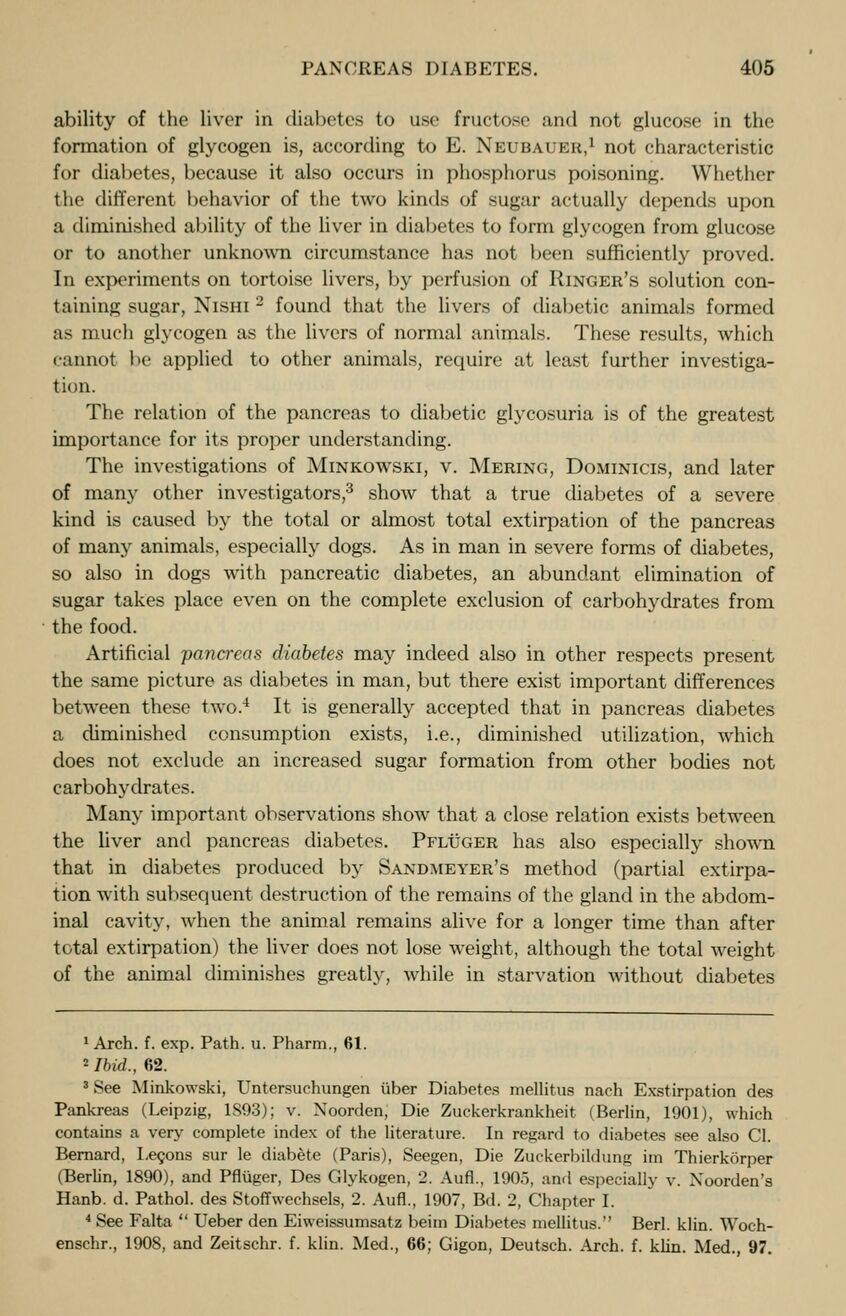
Full resolution (JPEG) - On this page / på denna sida - VII. The Liver - Glycogen and its Formation

<< prev. page << föreg. sida << >> nästa sida >> next page >>
Below is the raw OCR text
from the above scanned image.
Do you see an error? Proofread the page now!
Här nedan syns maskintolkade texten från faksimilbilden ovan.
Ser du något fel? Korrekturläs sidan nu!
This page has never been proofread. / Denna sida har aldrig korrekturlästs.
PANCREAS DIABETES. 405
ability of the liver in diabetes to use fructose and not glucose in the
formation of glycogen is, according to E. Neubauer,1
not characteristic
for diabetes, because it also occurs in phosphorus poisoning. Whether
the different behavior of the two kinds of sugar actually depends upon
a diminished ability of the liver in diabetes to form glycogen from glucose
or to another unknown circumstance has not been sufficiently proved.
In experiments on tortoise livers, by perfusion of Ringer’s solution con-
taining sugar, Nishi 2
found that the livers of diabetic animals formed
as much glycogen as the livers of normal animals. These results, which
cannot be applied to other animals, require at least further investiga-
tion.
The relation of the pancreas to diabetic glycosuria is of the greatest
importance for its proper understanding.
The investigations of Minkowski, v. Mering, Dominicis, and later
of many other investigators,3
show that a true diabetes of a severe
kind is caused by the total or almost total extirpation of the pancreas
of many animals, especially dogs. As in man in severe forms of diabetes,
so also in dogs with pancreatic diabetes, an abundant elimination of
sugar takes place even on the complete exclusion of carbohydrates from
the food.
Artificial pancreas diabetes may indeed also in other respects present
the same picture as diabetes in man, but there exist important differences
between these two.4
It is generally accepted that in pancreas diabetes
a diminished consumption exists, i.e., diminished utilization, which
does not exclude an increased sugar formation from other bodies not
carbohydrates.
Many important observations show that a close relation exists between
the liver and pancreas diabetes. Pfluger has also especially shown
that in diabetes produced by Sandmeyer’s method (partial extirpa-
tion with subsequent destruction of the remains of the gland in the abdom-
inal cavity, when the animal remains alive for a longer time than after
total extirpation) the liver does not lose weight, although the total weight
of the animal diminishes greatly, while in starvation without diabetes
1
Arch. f. exp. Path. u. Pharm., 61.
2
Ibid., 62.
3
See Minkowski, Untersuchungen liber Diabetes mellitus nach Exstirpation des
Pankreas (Leipzig, 1S93); v. Noorden, Die Zuckerkrankheit (Berlin, 1901), which
contains a very complete index of the literature. In regard to diabetes see also CI.
Bernard, I.econs sur le diabete (Paris), Seegen, Die Zuckerbildung im Thierkorper
(Berlin, 1890), and Pfluger, Des Glykogen, 2. Aufl., 1905, and especially v. Xoorden’s
Hanb. d. Pathol, des Stoffwechsels, 2. Aufl., 1907, Bd. 2, Chapter I.
4
See Falta " Ueber den Eiweissumsatz beim Diabetes mellitus." Berl. klin. Woch-
enschr., 1908, and Zeitschr. f. klin. Med., 66; Gigon, Deutsch. Arch. f. klin. Med., 97.
<< prev. page << föreg. sida << >> nästa sida >> next page >>